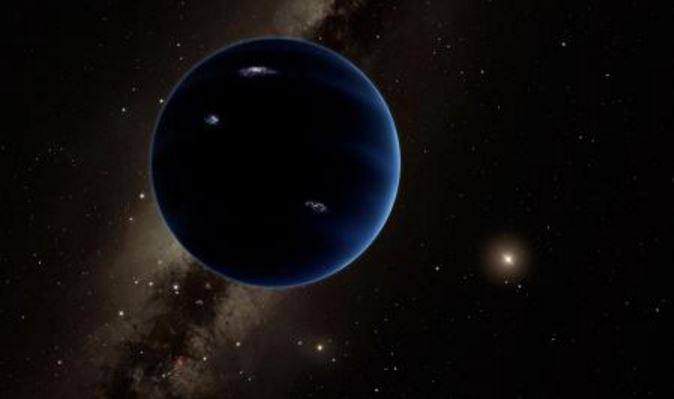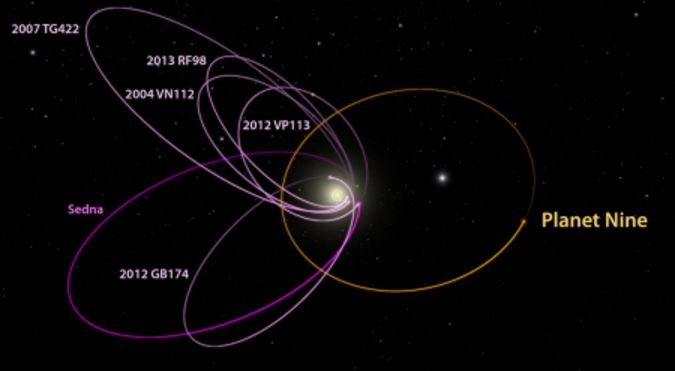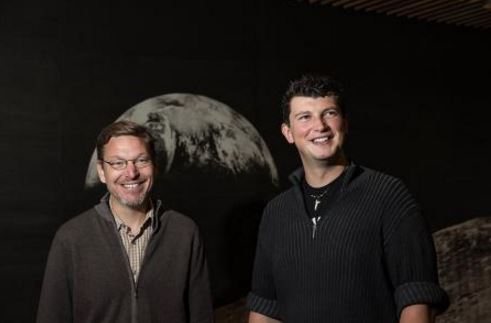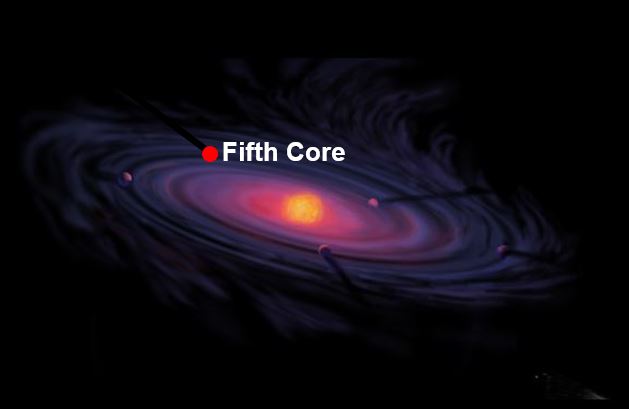A ninth planet, which has been discovered in the outer solar system with a mass ten times that of Earth and about four times its size, by scientists at Caltech (California Institute of Technology), has the global astronomy community in a buzz. This large planet is so distant from the Sun that it probably takes from 10,000 to 20,000 years to complete one full orbit.
Professors Mike Brown and Konstantin Batygin, who both work at Caltech’s Division of Geological and Planetary Sciences, say this newly-discovered planet orbits approximately 20 times farther from the Sun than does Neptune, which has an average distance from the Sun of 2.8 billion miles.
The two astronomers explained in the current issue of Astronomical Journal that they discovered the existence of the ninth planet through computer simulations and mathematical modeling, but have not yet seen it directly.
 An artist’s impression of Planet Nine with the Sun in the background. It is thought to be a gaseous planet, similar to Neptune and Uranus. (Image: Caltech/R. Hurt)
An artist’s impression of Planet Nine with the Sun in the background. It is thought to be a gaseous planet, similar to Neptune and Uranus. (Image: Caltech/R. Hurt)
Large chunk of solar system waiting to be found
Prof. Brown, the Richard and Barbara Rosenberg Professor of Planetary Astronomy, said:
“This would be a real ninth planet. There have only been two true planets discovered since ancient times, and this would be a third. It’s a pretty substantial chunk of our solar system that’s still out there to be found, which is pretty exciting.”
Prof. Brown notes that the alleged ninth planet – which is 5,000 times the mass of Pluto – is large enough so that there should be no debate on whether it really is a true planet.
Planet Nine’s gravity dominates its neighbourhood of the solar system. In fact, its gravity dominates a larger region than any of the other known planets – a fact that the authors say makes it “the most planet-y of the planets in the whole solar system.”
The researchers explain how Planet Nine helps answer many questions regarding the mysterious features of the Kuiper Belt – the field of debris and icy objects beyond Neptune.
 The 6 most distant known objects in the solar system with orbits exclusively beyond Neptune. They all mysteriously line up in a single direction. (Image: Caltech/R. Hurt)
The 6 most distant known objects in the solar system with orbits exclusively beyond Neptune. They all mysteriously line up in a single direction. (Image: Caltech/R. Hurt)
From skeptical to persuaded
Prof. Batygin, an assistant professor of planetary science, said:
“Although we were initially quite skeptical that this planet could exist, as we continued to investigate its orbit and what it would mean for the outer solar system, we become increasingly convinced that it is out there.”
“For the first time in over 150 years, there is solid evidence that the solar system’s planetary census is incomplete.”
The authors said the path that led to the theoretical discovery was not straightforward. In 2014, Chad Trujillo, a former postdoc of Brown’s, and colleague Scott Sheppard published an article noting that thirteen of the most distant objects within the Kuiper Belt are similar in that they all have an obscure orbital feature.
They suspected this strange orbital feature was caused by a small planet. Prof. Brown did not think the planet solution was likely, but he became interested.
He presented the problem to Prof. Batygin, and the two astronomers began what became a 2.5-year collaboration to investigate distant objects.
 Professors Mike Brown & Konstanin Batygin have been working together to investigate distant objects in our solar system for more than 18 months. The two bring very different perspectives to the work – Brown is the observer while Batygin the theorist. (Image: Lance Hayashida/Caltech)
Professors Mike Brown & Konstanin Batygin have been working together to investigate distant objects in our solar system for more than 18 months. The two bring very different perspectives to the work – Brown is the observer while Batygin the theorist. (Image: Lance Hayashida/Caltech)
Two different approaches to space research
As an observer and a theorist, respectively, the scientists approached their tasks from completely different perspectives – Prof. Brown as a person who looks at the sky and attempts to anchor everything in the context of what can be observed, and Prof. Batygin who looks at everything from the dynamics angle, considering how things could work from a physics standpoint.
Thanks to those differences, the two scientists were able to challenge each other’s ideas and consider new possibilities.
Prof. Brown said:
“I would bring in some of these observational aspects; he would come back with arguments from theory, and we would push each other. I don’t think the discovery would have happened without that back and forth.”
“It was perhaps the most fun year of working on a problem in the solar system that I’ve ever had.”
 Scientists believe there were four cores in the early solar system when planets were being formed, which produced the gas planets – Neptune, Uranus, Saturn and Jupiter. Perhaps Planet Nine comes from a fifth core. (Image adapted from Wikipedia)
Scientists believe there were four cores in the early solar system when planets were being formed, which produced the gas planets – Neptune, Uranus, Saturn and Jupiter. Perhaps Planet Nine comes from a fifth core. (Image adapted from Wikipedia)
Unusual orbit patterns observed
They soon realized that the six most distant objects from Shepherd and Trujillo’s initial observation all follow elliptical orbits that point in the same direction in physical space. That is surprising, because they travel at different speeds and the outermost points of their orbits move around the solar system.
This is a bit like having a clock with six hands, all of them moving at different speeds. However, when you look up at them, they are all in the same place. The chances of something like that to happen are less than 1 in 100, Prof. Brown said.
They also found that the six objects are all tilted identically – pointing to about 30 degrees downward in the same direction relative to the plane of the eight planets we know about.
The chances of that happening are even smaller – about 0.007%. “Basically it shouldn’t happen randomly. So we thought something else must be shaping these orbits,” Prof. Brown said.
They first looked into whether there might be enough distant objects in the Kuiper Belt – some of which have not been discovered yet – to exert the gravity required to keep that subpopulation of objects clustered together.
This was soon ruled out when they calculated that the Kuiper Belt would need about 100 times its current mass for such a scenario to be possible.
So they were left with the idea of a planet. Initially, their instinct was to run simulations involving a distant planet in a faraway orbit that encircled the orbits of the six objects in the Kuiper Belt, acting like a mega lasso to wrangle them into alignment.
Prof. Batygin said that nearly works, but does not explain the observed eccentricities precisely. “Close, but no cigar,” he said.
Large planet possibility reached by accident
Then, by accident, the two scientists noticed that if they used a massive planet in their simulations, one in an anti-aligned orbit – one in which the planet’s perihelion (closest approach to the sun) is 180 degrees across from the perihelion of the other objects and known planets – the Kuiper Belt objects in the simulation assumed the alignment that is actually observed.
Prof. Batygin said:
“Your natural response is ‘This orbital geometry can’t be right. This can’t be stable over the long term because, after all, this would cause the planet and these objects to meet and eventually collide.’”
However, through a mechanism called mean-motion resonance, the ninth planet’s anti-aligned orbit prevents the Kuiper Belt objects from crashing into it and keeps them aligned.
As orbiting planets and objects approach each other they exchange energy. So, for example, for every four orbits made by Planet Nine, a distant Kuiper Belt object might do nine orbits.
The objects and Planet Nine never collide. Rather, like a parent pushing a child on a swing periodically and maintaining an arc, the large planet nudges the orbits of the distant Kuiper Belt objects so that their configuration with relation to the planet is preserved.
Prof. Batygin said:
“Still, I was very skeptical. I had never seen anything like this in celestial mechanics.”
However, ever so gradually, as the two scientists investigated more features and consequences of the model, they became persuaded.
Regarding how a good theory is born, Prof. Batygin said:
“A good theory should not only explain things that you set out to explain. It should hopefully explain things that you didn’t set out to explain and make predictions that are testable.”
Planet Nine explains alignment and bizarre orbits
Not only does the existence of Planet Nine help explain the alignment of the distant Kuiper Belt objects, it also explains their mysterious orbits.
The first of those distant objects, nicknamed Sedna, was discovered in 2003 by Prof. Brown. Unlike most Kuiper Belt objects, which get ‘kicked out’ by Neptune’s gravity and then return to it, Sedna never gets very near to Neptune.
A second object similar to Sedna, known as 2012 VP113, was announced by Shepherd and Trujillo in 2014. Professors Brown and Batygin found that the presence of Planet Nine in its proposed orbit naturally produces Sedna-like objects by slowly pulling away a standard Kuiper Belt object into an orbit less connected to Neptune.
However, the real kicker for the scientists was the fact that their simulations also predicted that there would be objects in the Kuiper Belt that followed orbits that were inclined perpendicularly to the plane of the planets.
As Prof. Batygin found evidence of these in his simulation – and there were many – he took them to Prof. Brown. “Suddenly I realized there are objects like that,” recalled Brown.
Over the past three years, observers have spotted four objects following orbits roughly along one perpendicular line from Neptune and one object along another.
Prof. Brown plotted up the positions of those objects, as well as their orbits, and found they matched the simulations exactly. “When we found that, my jaw sort of hit the floor,” Prof. Brown said.
Killed two birds with one stone plus one extra
Prof. Batygin said:
“When the simulation aligned the distant Kuiper Belt objects and created objects like Sedna, we thought this is kind of awesome – you kill two birds with one stone.”
“But with the existence of the planet also explaining these perpendicular orbits, not only do you kill two birds, you also take down a bird that you didn’t realize was sitting in a nearby tree.”
So where did Planet Nine come from, and why is it in the outer solar system – how did it get there?
Scientists have long suggested that the early solar system started with four planetary cores that grabbed all the gas around them, forming the four gas planets – Neptune, Uranus, Saturn and Jupiter.
Collisions and ejections over time shaped them and moved them out to their current locations. “But there is no reason that there could not have been five cores, rather than four,” said Prof. Brown.
It is possible that Planet Nine represents that fifth core. If it got too near Saturn or Jupiter, it might have been kicked into its current distant, eccentric orbit.
Professors Brown and Batygin continue improving their simulations and are still learning more about the planet’s orbit and how it influences the distant solar system.
Big search for Planet Nine
Prof. Brown and other colleagues are currently scouring the skies for Planet Nine. We only know about its rough orbit, but have no precise data regarding exactly where it is on that elliptical path.
If Planet Nine is close to its perihelion, astronomers should be able to detect it in images captured by previous surveys. If it is as far away from the Sun as it can be, the world’s largest telescopes will be needed to see it. If it is somewhere in between, there are several telescopes across the world that could find it.
Prof. Brown said:
“I would love to find it. But I’d also be perfectly happy if someone else found it. That is why we’re publishing this paper. We hope that other people are going to get inspired and start searching.”
Prof. Batygin says that the presence Planet Nine makes our solar system more similar to other planetary systems that astronomers are discovering around other stars in two ways.
Firstly, most planets around other stars similar to our Sun have no single orbital range, i.e. some orbit super close to their host stars while others follow ultra-distant orbits. Secondly, the majority of common planets around other stars range between one and ten Earth-masses.
Prof. Batygin said:
“One of the most startling discoveries about other planetary systems has been that the most common type of planet out there has a mass between that of Earth and that of Neptune.”
“Until now, we’ve thought that the solar system was lacking in this most common type of planet. Maybe we’re more normal after all.”
Prof. Brown, who played a significant role in the demotion of Pluto from a planet to a dwarf planet, added:
“All those people who are mad that Pluto is no longer a planet can be thrilled to know that there is a real planet out there still to be found,” he says. “Now we can go and find this planet and make the solar system have nine planets once again.”
Citation: “EVIDENCE FOR A DISTANT GIANT PLANET IN THE SOLAR SYSTEM,” Konstantin Batygin and Michael E. Brown. The Astronomical Journal. Published 20 January, 2016. DOI: 10.3847/0004-6256/151/2/22.
Video – Evidence of Ninth Planet
Professors Batygin & Brown discuss new research that provides evidence of a giant planet tracing a bizarre, highly elongated orbit in the outer solar system.

